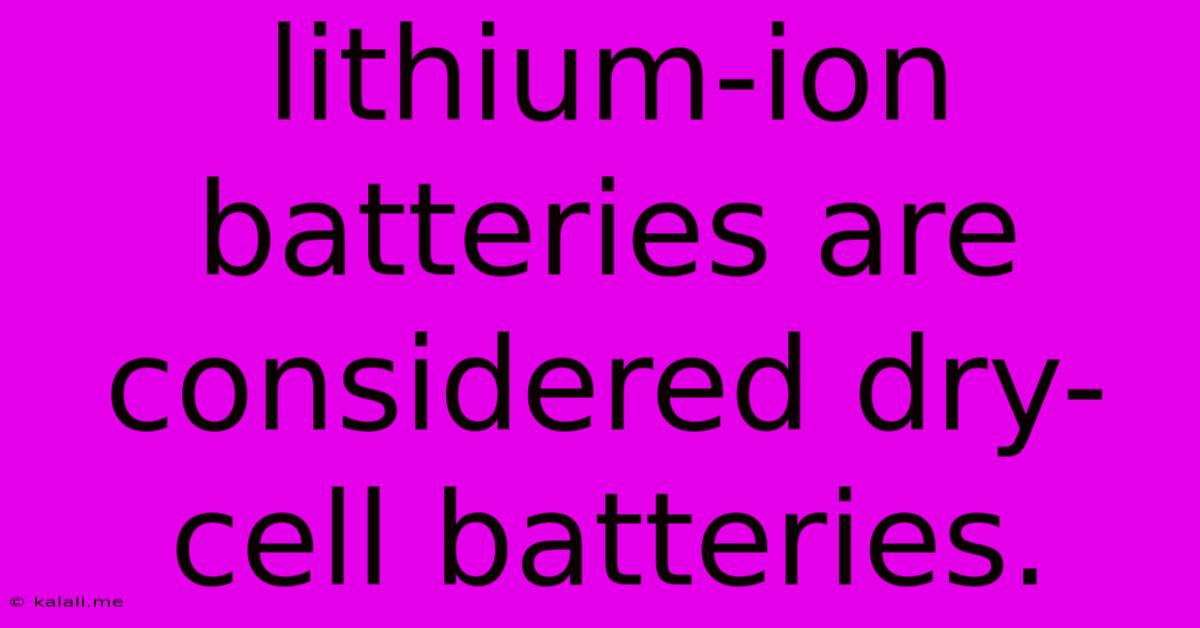Lithium-ion Batteries Are Considered Dry-cell Batteries.
Kalali
May 10, 2025 · 3 min read

Table of Contents
Are Lithium-Ion Batteries Considered Dry-Cell Batteries? Debunking the Myth
Meta Description: Lithium-ion batteries are often mistakenly classified as dry-cell batteries. This article clarifies the crucial differences between the two, highlighting the unique characteristics and functionalities of lithium-ion technology. We'll explore the electrolyte, construction, and overall performance to unveil the truth.
Lithium-ion batteries are ubiquitous in modern life, powering everything from smartphones and laptops to electric vehicles. A common misconception, however, is that they are a type of dry-cell battery. While both store electrical energy chemically, the similarities end there. This article will delve into the key differences between lithium-ion and dry-cell batteries, dispelling this misconception once and for all.
Understanding Dry-Cell Batteries
Dry-cell batteries, as their name suggests, utilize a relatively dry electrolyte. This electrolyte is typically a paste or a gel, rather than a liquid. Classic examples include zinc-carbon and alkaline batteries. These batteries are characterized by their:
- Simplicity: Their construction is relatively simple and inexpensive.
- Portability: They are generally compact and lightweight.
- Limited lifespan: They have a shorter lifespan compared to rechargeable batteries.
- Lower energy density: They provide less energy per unit of weight or volume.
The key defining feature is the non-spillable electrolyte, contributing to their safety and ease of handling.
Lithium-Ion Batteries: A Different Breed
Lithium-ion batteries operate on a fundamentally different principle. Although often referred to informally as "rechargeable batteries," they are distinct from other rechargeable technologies like nickel-cadmium (NiCd) or nickel-metal hydride (NiMH). Crucially, they do not use a dry electrolyte.
Instead, lithium-ion batteries employ a liquid electrolyte, usually an organic solvent containing lithium salts. This liquid electrolyte is crucial for the battery's operation, facilitating the movement of lithium ions between the anode and cathode during charge and discharge cycles. This liquid nature is a key differentiator from dry-cell batteries.
Further distinguishing features of lithium-ion batteries include:
- High energy density: They boast significantly higher energy density compared to dry-cell batteries.
- Rechargeability: They are rechargeable, offering multiple charge-discharge cycles.
- Higher voltage: They typically operate at a higher voltage than most dry-cell batteries.
- Complex construction: Their construction is more complex and involves multiple components.
- Potential safety concerns: The liquid electrolyte, while crucial for performance, poses potential safety risks if mishandled or damaged. This is particularly relevant regarding overheating and potential fire hazards.
Why the Misconception?
The misconception likely stems from the fact that both lithium-ion and dry-cell batteries store electrical energy chemically and are commonly used in portable devices. However, the underlying chemistry and construction are fundamentally different.
The use of a liquid electrolyte in lithium-ion batteries is a crucial distinction, making them categorically not dry-cell batteries. The terminology is a simplification, often leading to confusion.
Conclusion
In summary, while both lithium-ion and dry-cell batteries serve the purpose of energy storage, they are vastly different in their composition, functionality, and performance characteristics. The presence of a liquid electrolyte in lithium-ion batteries definitively excludes them from the dry-cell battery classification. Understanding these differences is crucial for proper handling, safety considerations, and appreciating the remarkable advancements in battery technology.
Latest Posts
Latest Posts
-
How Much Is 120 Kilograms In Pounds
Jul 12, 2025
-
Born In 1990 How Old Am I
Jul 12, 2025
-
What Is The Average Iq For A 5 Year Old
Jul 12, 2025
-
How Many 12 Oz Cups In A Gallon
Jul 12, 2025
-
How Much Older Is John The Baptist Than Jesus
Jul 12, 2025
Related Post
Thank you for visiting our website which covers about Lithium-ion Batteries Are Considered Dry-cell Batteries. . We hope the information provided has been useful to you. Feel free to contact us if you have any questions or need further assistance. See you next time and don't miss to bookmark.